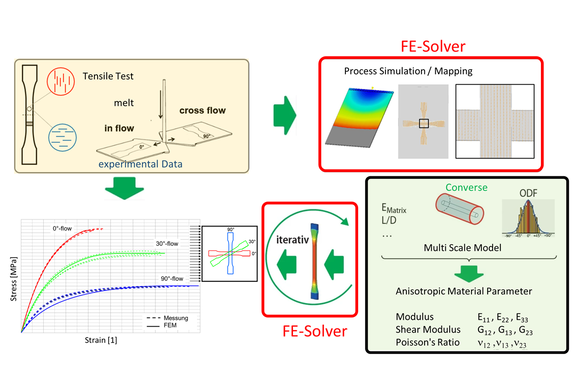The use of anisotropic material models in structural simulation is state of the art today if dealing with fiber reinforced thermoplastics. The errors regarding stiffness and strength are too large if the direction-dependent material behavior due to the fiber orientations is ignored. A major problem in the use of such models is the calibration of the model parameters. In contrast to tensile tests on isotropic and homogeneous materials, the tensile test on a fiber-reinforced specimen does not directly provide the material behavior, but only the stiffness of a inhomogeneous composite with layers of differently oriented fibers (see Figure 1). The orientation itself in the tested specimens is unknown.
In the injection molding process of the specimen, a basically three layered structure is formed in the specimen. The outer layers, which are relatively highly oriented in the direction of flow, enclose a middle layer with a rather low orientation. The properties of the individual layers ultimately depends on the velocity profile of the melt. Influencing parameters include melt viscosity, wall thickness and injection speed. The tensile tests of such a sandwich specimen yield the integral stiffness behavior of all three layers.
For this reason, FEM simulations are required at two points in the calibration process for material models. First, the fiber orientation in the specimen must be predicted. If not measured by evaluating CT scans, this is achieved by a filling simulation of the specimen or the test plate used. Secondly, the local orientations have to be incorporated into a structural FE-model and the tensile test itself must be simulated in order to validate that the assumed material behavior corresponds to the measured values from the test. Ultimately, the correct adjustment of the model parameters used can only be carried out iteratively by comparing the test and simulation data (Figure 2).
While highly effective, finite element solvers can be computationally expensive and require significant human effort and Know How in model setup and parameter tuning. Furthermore, in the first place these solvers have to be available for the material expert who’s task it is to create valid material models. This complex and expensive workflow often is a reason for the hesitant use of such models. Especially in the deadline-driven world of product development.
However, with the rapid advancements in Artificial Intelligence (AI), an exciting paradigm shift is underway. AI models are emerging as promising replacements for traditional finite element solvers, transforming the way we approach both rheological and structural simulations.
AI's arrival on the scene has sparked revolutionary changes in simulation methodologies. Especially for a very well defined task, like the filling of a simple plate or a tensile test specimen or the mechanical response of such a specimen under uniaxial loading, the capabilities for AI models are very promising.
For this reason, since the middle of this year, PART Engineering has joined a publicly funded research project that is aiming on the development of two corresponding AI models. One model shall predict the fiber orientations in several standard mold geometries, while the other shall predict the stiffness behavior of a tensile specimen with a given fiber orientation profile. The project partners are the SKZ Würzburg Das Kunststoff-Zentrum and the company aiXtrusion. This partnership brings together many years of experience in the fields of material modeling, materials testing and the training of AI models.
The goal of this project is the development and implementation of an AI based algorithm for the calibration of anisotropic material models without the need of any external or internal FE solver. This algorithm, including the two AI models, will then be implemented in the MatScape software package and in this way simplify the process of material calibration significantly for the user (Figure 3).
AI-Driven Workflow for Anisotropic Material Model Generation
AI models can be trained on a diverse range of rheological data, including viscosity, shear stress, and yield behavior, to predict complex material responses. By learning from data generated through experiments or simulations, trained AI models can approximate material behaviors more efficiently and accurately than traditional methods. In particular, an AI model should be capable of predicting the local fiber orientations in a simple geometry if trained sufficiently. For the filling simulation, the parameters of the viscosity model, the wall thickness and melt temperature and the injection speed are provided as input values. By suitable variation of these parameters in the filling simulation, a sufficient amount of training data is generated for different AI models.
In structural analysis, AI models can predict stress distribution, deformation, and failure modes of materials and structures. By training on data from tensile tests and simulations, AI models can generate predictions for different loading scenarios. The uniaxial response of a simple dog bone specimen, even with locally varying fiber orientations should be a realistic goal for an AI model.
The process of using AI for anisotropic material model generation involves several steps:
- Gather experimental data or high-fidelity simulation results that capture the behavior of the material under various parameter settings. For the prediction of the local fiber orientation, parameters will be the viscosity, mold geometry and selected process data. For the prediction of the loading/displacement response of the tensile test, the varying boundary conditions are the mechanical properties of the matrix and fiber materials and the fiber orientations predicted from the first AI model.
- Data Preprocessing: Clean, normalize, and organize the data to create a suitable dataset for training the AI model.
- Model Selection: Choose an appropriate AI model architecture of neural networks, with different numbers of neurons and layers, based on the complexity of the material's behavior and the available data.
- Training: Feed the preprocessed data into the AI model and train it to learn the relationships between material parameters, boundary conditions, and system responses.
- Validation and Refinement: Validate the trained AI model's accuracy using unseen data or experimental results. Refine the model iteratively to improve its predictions.
- Optimization: Integration of the KI model into the software MatScape, to generate anisotropic material models that can be directly integrated into simulation software.
Benefits and Future Implications
The integration of AI in generating anisotropic material models brings forth several benefits.
AI models can capture intricate behaviors that might be missed by traditional models, leading to more accurate simulations. This is especially true, if real CT-data is used for training, thus avoiding the errors regarding the real local fiber orientation predicted by filling simulations. Additionally, AI significantly reduces the time required for model development, enabling engineers to focus on other aspects of the simulation process. With neither the license fees for two FE-solvers, nor the required Know How in using theses solvers, the required effort is reduced significantly.
As AI continues to advance, the collaboration between AI and material science holds the potential to revolutionize material modeling, enabling simulations that closely mirror real-world behaviors.
We are very much looking forward to working together on this project and are convinced that the results will be of direct benefit to the users of our software.
Author: Dr. Marcus Stojek is Managing Director at PART Engineering GmbH, Bergisch Gladbach, Germany



